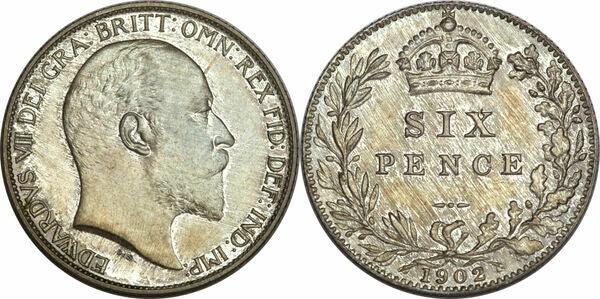The British sixpence, sometimes affectionately known as a 'tanner' or 'sixpenny bit,' was a denomination of sterling coinage.
Origins and Introduction:
The first sixpences were minted in 1551, during the reign of Edward VI. They emerged due to the debasement of silver coinage in the 1540s, particularly the silver testoon, which fell in value from 12 pence to 6 pence. The decision was made to introduce a new coin with the express denomination of six pence.
Design Evolution
Over the centuries, the sixpence underwent various design changes, reflecting the reigning monarchs, artistic trends, and cultural influences of each era.
The obverse typically featured a profile of the monarch, while the reverse showcased various designs, including floral motifs.
Young Head Victoria Sixpence (1838-1887):

Design
The obverse features a young portrait of Queen Victoria with ribbons in her hair. The reverse displays the words “SIX PENCE” beneath a royal crown, surrounded by an oak wreath tied with a bow.
Estimated value is between £20 and £75 depending on the condition.
Jubilee Victoria Sixpence (1887-1893):
 Design
Design
Minted during Queen Victoria’s Golden Jubilee, this sixpence showcases a mature portrait of the queen on the obverse. The reverse design remains similar to the Young Head version.
Estimated value is around £10 - £15
Old Veiled Head Victoria Sixpence (1893-1901)

Design
The Veiled Head design features Queen Victoria with a veil covering her head. The reverse remains consistent with the oak wreath and bow.
Estimated value is around £20
Edward VII Sixpence (1902-1910)

Design
King Edward VII’s portrait graces the obverse, while the reverse maintains the traditional elements.
Estimated value is around £15
George V Sixpence (1911-1936)

Design
George V’s profile appears on the obverse. The reverse design remained consistent up until 1928 when it was replaced by an intricate design of six acorns entwined by six oak sprigs, which are symbols of strength and stability.
 Estimated value varies but generally not as high as earlier versions, around £5
Estimated value varies but generally not as high as earlier versions, around £5
George VI Sixpence (1937-1952)

Design
King George VI’s portrait replaces the previous monarch’s image. Upon George VI ascending to the throne in 1937 following his elder brother Edward VIII's abdication, a new reverse design for the sixpence emerged. It featured George VI’s regal cypher below a majestic crown, flanked by the year of mintage on both sides.
Estimated value is approximately £4
Elizabeth II Sixpence (1953-1967)

Design
Queen Elizabeth II’s youthful portrait graces the obverse. The reverse design features a floral arrangement with a Tudor rose, thistle, shamrock, and leek, symbolizing the four Home Nations.
Estimated value is around £2
Remember that the value of these coins depends on factors such as rarity, condition, and historical significance. Collectors often appreciate the cultural and numismatic aspects of sixpences, making them more valuable than their face value.
Material Composition:
From its introduction in 1551 until 1947, the sixpence was made from silver. After 1947, it was minted in cupronickel (a copper-nickel alloy).
Decimalisation and Legacy:
Before Decimal Day in 1971, the sixpence was part of the £sd (pounds, shillings, and pence) system. Following decimalisation, it had a value of 2.5 new pence (£0.025). The nickname “tanner” persisted until the transition to decimal currency.
Bit of Trivia
The rarest sixpences include those struck in 1952, with only a small batch issued before King George VI’s death. These were sent to Jamaica.
In recent years, the Royal Mint has minted new decimal sixpences as commemorative issues to celebrate Christmas. These coins are produced in sterling silver.


2 comments
canadian pharmaceuticals usa
It’s very easy to find out any matter on net as compared to books, as I found this post at this web site.
Cookie Monster
Thanks good reading happydays